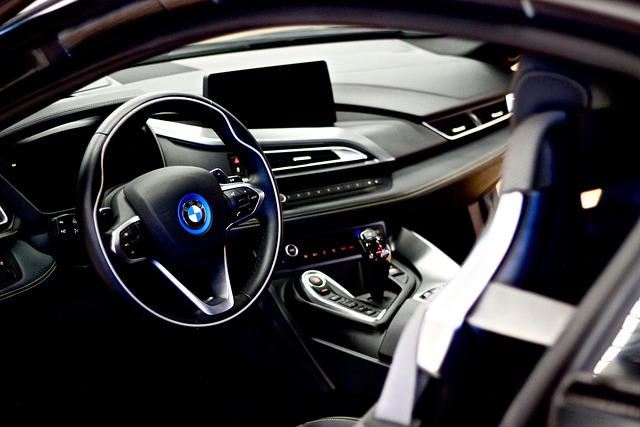Advanced in-car infotainment systems, while enhancing driver connectivity, pose a risk of distraction. Despite features designed for hands-free operation, like voice recognition and digital cockpits, maintaining road focus is crucial. Balancing connectivity and safety is essential, especially with growing popularity of these systems. Real-time alerts integrated into digital interfaces, including collision avoidance and GPS mapping, minimize distractions while keeping drivers informed. Future advancements in machine learning and AI will adapt warning systems to individual driving styles, leveraging in-car infotainment and ensuring optimal safety through regular software updates. Selecting modern vehicles with robust in-car infotainment capabilities is key to achieving a secure, connected driving experience.
In today’s digital age, enhancing driver safety through advanced technology is paramount. This article explores how Select In-Car Infotainment systems can revolutionize road security by addressing the growing concern of driver distraction. We delve into the current landscape, examining the role of infotainment in safety and the potential of alert systems integrated with sensors. From designing context-aware alerts to future implications, this comprehensive guide highlights strategies to create more secure driving experiences.
- Understanding Driver Distraction: The Current Landscape
- The Role of In-Car Infotainment Systems in Safety
- Integrating Alerts and Sensor Technology
- Designing Effective Driver Alerts for Different Scenarios
- Future Implications and Continuous Improvement
Understanding Driver Distraction: The Current Landscape

Driver distraction is a growing concern on roads worldwide, with various factors contributing to this issue. The current landscape reveals that modern vehicles, equipped with advanced infotainment systems, can sometimes become a source of diversion for drivers. In-car entertainment and navigation options, while convenient, demand the driver’s attention, leading to a potential conflict between focusing on the road and interacting with these features. This is especially true for traditional systems that require manual operation and visual reference.
The rise of smart, connected cars has introduced new elements like digital cockpit displays and voice recognition infotainment. These innovations aim to enhance hands-free driving by allowing drivers to manage various tasks without taking their eyes off the road. However, as these technologies become more prevalent, it’s crucial to understand how they might impact driver safety and find a balance between staying connected and maintaining full awareness while driving.
The Role of In-Car Infotainment Systems in Safety

In-Car Infotainment Systems have evolved from simple audio players to become integral parts of modern driving experiences, offering much more than entertainment. These systems play a pivotal role in enhancing driver safety by providing essential tools and alerts. With advanced features like GPS mapping software integrated into these systems, drivers can easily navigate unfamiliar routes, reducing the risk of getting lost. Additionally, wireless smartphone integration allows for hands-free calling and text messaging, minimizing distractions that could lead to accidents.
Modern car audio trends focus on intuitive user interfaces and voice command capabilities, making it easier for drivers to access safety features without taking their eyes off the road. The ability to quickly pull up real-time traffic updates, weather warnings, and collision avoidance systems can significantly contribute to overall driver safety. These in-car infotainment features not only keep drivers informed but also enable them to react swiftly to potential hazards on the road.
Integrating Alerts and Sensor Technology

Modern vehicles are equipped with an array of sensors and technologies that can significantly enhance driver safety when integrated effectively. One such innovation is the implementation of alerts within the in-car infotainment system, which goes beyond simple entertainment. These alerts leverage sensors to provide real-time data on various driving conditions, such as collision avoidance systems, lane departure warnings, and adaptive cruise control. By seamlessly integrating these features into the digital cockpit display, drivers receive instant notifications without diverting their attention from the road.
The in-car entertainment system has evolved to become a critical component of driver safety, offering more than just music streaming services for cars. It acts as a central hub for processing and displaying vital information. This technology allows drivers to stay informed about potential hazards, enabling them to react swiftly and make informed decisions on the fly. As these systems continue to advance, they promise to revolutionize in-car experiences, fostering safer driving environments for everyone on the road.
Designing Effective Driver Alerts for Different Scenarios

Designing effective driver alerts requires understanding the diverse needs and scenarios drivers face daily. These alerts should be tailored to ensure they are easily discernible and act as a genuine aid, not a distraction. For instance, visual alerts like flashing dashboard lights or dedicated warning displays can effectively convey immediate hazards, while auditory cues such as distinct chimes or voice notifications are crucial for subtle reminders or navigation instructions.
Integrating these alerts with the in-car infotainment system is essential. Advanced audio controls on the steering wheel allow drivers to adjust volume or access navigation without taking eyes off the road. GPS mapping software can be synchronized with alerts, providing turn-by-turn directions that complement visual and auditory warnings for a comprehensive safety experience. The goal is to select and integrate features that offer both premium sound quality in cars and seamless functionality, enhancing driver safety across various conditions and trips.
Future Implications and Continuous Improvement

As technology continues to evolve, the future of driver safety through alerts looks promising and multifaceted. With advancements in machine learning and artificial intelligence, we can expect even more sophisticated warning systems that adapt to individual driving styles and patterns. These systems will likely become standard features in new vehicles, utilizing in-car infotainment systems with Apple CarPlay compatibility to seamlessly integrate advanced driver assistance systems (ADAS). Continuous improvements in affordable car audio systems, complete with robust in-car internet access, will enable real-time data processing, enhancing the accuracy and responsiveness of safety alerts.
Regular updates and over-the-air software patches will play a crucial role in maintaining optimal performance, addressing any emerging issues, and incorporating new safety features. This ongoing evolution underscores the importance of choosing modern vehicles with robust infotainment capabilities as we move forward. Such systems not only enhance driver safety but also contribute to a more efficient, connected, and secure driving experience for all.
By integrating advanced alert systems with modern in-car infotainment technology, we can significantly enhance driver safety. As our understanding of distraction continues to evolve, so too must the features built into these systems. Through continuous research and development, we can create more effective alerts tailored to specific driving scenarios, ultimately reducing accidents and fostering a safer motoring environment. The future of driver safety lies in the seamless fusion of cutting-edge technology and responsible design.
